
| Animalia | Psittaciformes | Psittacidae | Poicephalus | Poicephalus senegalus |
The Senegal parrot (Poicephalus senegalus) is renowned as one of the most popular parrot species kept as pets. With their charming personality, small size, and ability to mimic sounds and words, these West African natives have captivated owners worldwide.
Senegal parrots are known for emitting an array of whistles and squawks to communicate. They form strong social bonds not only with each other, but also with their human caregivers.


- Common Name(s): Senegal Parrot, Yellow-Vented Parrot
- Family: Psittacidae
- Body Dimensions: About 23 cm long
- Male Plumage Color(s): Charcoal Grey Head, Grey Beak, Green Back and Throat, Yellow Underparts and Rump
- Female Plumage Color(s): Same as Male
- Habitat: Open Woodland and Savanna
- Diet: Fruit, Seeds, Blossoms
- Native Countries: Wide range across West Africa
- Continent(s): Africa
- Taxonomy Classification Year: 1766
- Taxonomist(s): Carl Linnaeus
In the wild, Senegal parrots inhabit savannas and wooded grasslands in countries like Senegal, Mauritania, Mali, and Guinea, where they forage for seeds, fruits, blossoms, and vegetation. Though considered a crop pest by some African farmers, Senegal parrot numbers remain stable. The species is classified as Least Concern on the IUCN Red List.
This article provides a comprehensive overview of Senegal parrots, from their taxonomy and physical features to behavior, breeding patterns, and popularity in aviculture. Fun facts about this charismatic species are also highlighted. Read on to learn what makes the Senegal parrot such a delightful companion!
Senegal Parrot Taxonomy and Physical Features
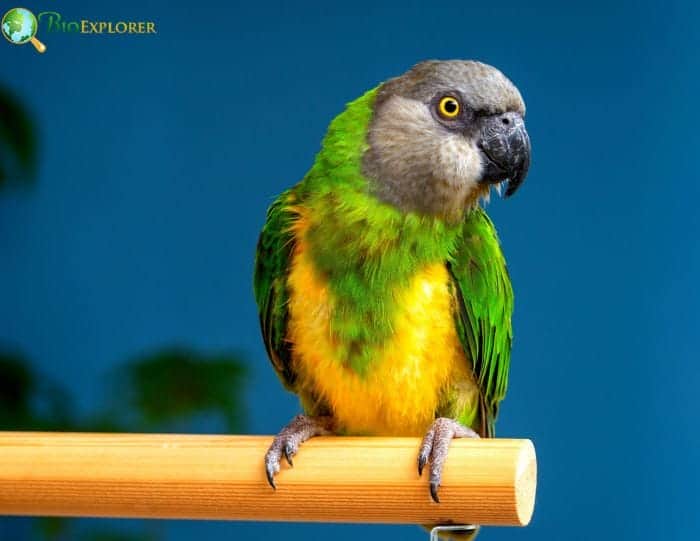
The Senegal parrot belongs to the scientific genus Poicephalus in the parrot family Psittacidae. Its binomial name is Poicephalus senegalus. Within this genus, two subspecies of Senegal parrots are recognized:
- P. s. senegalus: The nominate subspecies exhibit a bright yellow vest and green wings/body. Its native range spans across Senegal, southern Mauritania, southern Mali, Guinea, and Lobos Island off the coast of Senegal.
- P. s. versteri: Native to the Ivory Coast and Ghana in West Africa. Its deeper orange-red colored vest can distinguish it. The two subspecies are identical in behavior only differing in vest coloration.
Senegal Parrot Size and Physical Attributes
- Length: Approximately 9 inches (22-24 cm).
- Weight: Ranges between 4.1-6.3 ounces (120-180 grams).
- Compact body shape with a proportionally large head and short, broad tail.
- Smooth bronze-gray cere (fleshy base of the upper beak).
Senegal Parrot Plumage
- Head: Smokey charcoal-gray crown, cheeks, throat and nape.
- Beak: Charcoal-gray upper mandible and horn-colored lower mandible.
- Eyes: Dark brown Irises, surrounded by smoky white eye-rings.
- Body: Green upper back and wing coverts. Yellow-green underparts, thigh feathers, and under tail coverts.
- Rump and upper tail coverts: Bright yellow.
- Wings: Green with black flight feathers and red wing bending.
- Legs: Pinkish-gray feet with black talons.
- Vest: Yellow or deep orange-red breast band forming a distinct V-shape.
Senegal Parrot Gender Differences
No conspicuous sexual dimorphism exists in Senegal parrots. However, some subtle physical and size differences help indicate gender:
- Females tend to have longer, wider V-shaped vests.
- Females generally have slightly narrower heads and beaks.
- Males are typically larger and heavier than females.
Senegal Parrot Taxonomic History
French zoologist Mathurin Jacques Brisson coined the scientific name Psittacula senegalensis in 1760. Carl Linnaeus later reclassified the species as Psittacus senegalus in 1766. It was eventually moved to its current Poicephalus genus by English naturalist William John Swainson in 1837.
Senegal Parrot Habitat
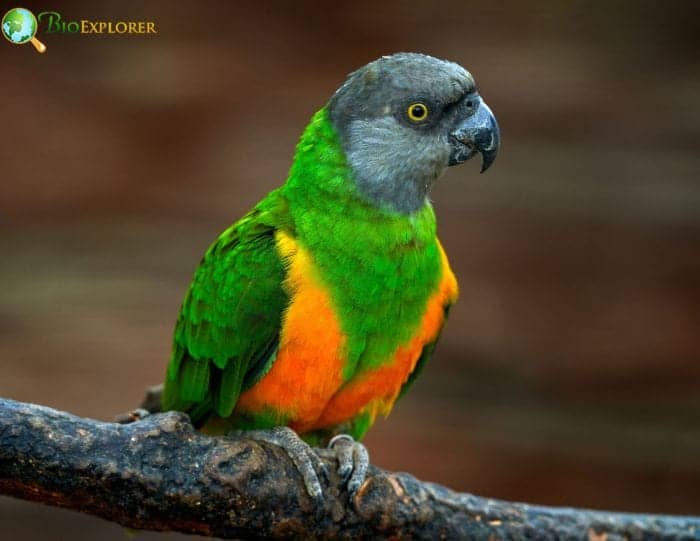
Senegal parrots inhabit the dry, open woodlands and savanna mosaic ecosystems of West Africa. The variety of trees in these grassland ecosystems provides roosting spots and nesting cavities. Specific vegetation varies across their range:
Senegal/Gambia
- Acacia trees, baobab trees.
- Oil palms near water sources.
Mali
- Drought-resistant shrubs like Calotropis.
- Kapok, fig, and cassia trees.
Ghana/Ivory Coast
- Mango trees, date palms.
- Teak, shea, and kapok trees.
Birds roost in trees near waterways and fields. They occupy orchards and areas of human cultivation. Seasonal migration follows fruit ripening patterns across the landscape.
What Do Senegal Parrots Eat?
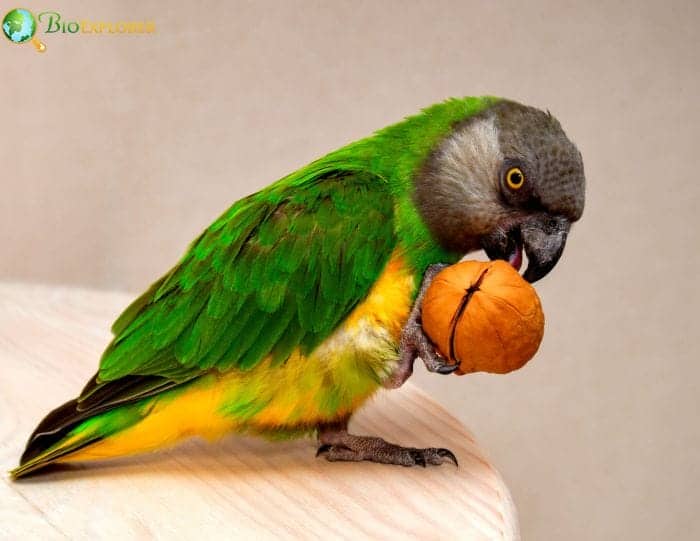
Senegal parrots are opportunistic generalists, adapting their diet based on food availability. Their main natural diet consists of:
- Fruit: Figs, African grapes, shea fruits, berries, dates.
- Seeds: Herbaceous plants, grasses, shrubs, quinoa.
- Vegetation: Blossoms, buds, stems, leaves.
Captive studies reveal a 77% fruit, 22% seed, and 1% flower diet composition.
Senegal Parrot Foraging Behavior
- Use strong beak to crack hard nuts/seeds.
- Employ climbing, hanging, limited digging behaviors.
- Forage in the early morning and late afternoon.
- Feed individually or in pairs not large flocks.
- Flock defense of fruit trees from other birds.
- Raid cultivated fruits and grains.
Senegal Parrot Breeding and Nesting

Senegal parrots reach reproductive maturity between 3 and 5 years old. The breeding season aligns with the onset of the rainy period in their West African habitat, from May to October.
Courtship displays involve eye pinning, beak rubbing, mutual feeding, and vocal duets. Once paired, the monogamous mates remain faithful in subsequent breeding seasons.
- Nest Sites: Cavities in living trees, typically oil palms, are preferred nesting sites. Senegal parrots also occupy old woodpecker holes and man-made nest boxes 3-15 meters high. Lined with decayed wood flakes, the inner chamber measures approximately 30 cm wide and 15 cm deep.
- Clutch Size and Eggs: The average clutch contains 3-4 white eggs, though ranges between 2-5 have been reported. The eggs measure roughly 3 cm long x 2.5 cm wide and weigh 8 grams. The female responsible for incubating the eggs. Hatching is asynchronous, occurring after an incubation period of 26-28 days.
- Chick Development: According to Texas State University researcher Reyes, newly hatched chicks initially have sparse white down. Eyes remain closed for up to 21 days post-hatching. The female rarely leaves the nest for the first month while the male regularly brings food. Full juvenile plumage emerges around 4 weeks. Young fledge at approximately 63 days old and reach independence soon after.
Senegal Parrot Behavior and Communication
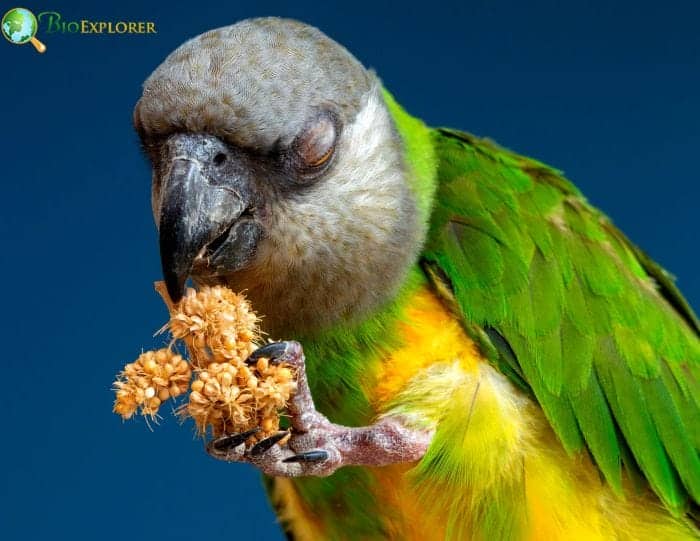
Senegal parrots live in dynamic flocks of 30-50+ birds in the wild. During the day, smaller foraging groups of 2-12 individuals splinter off and then return to communal roosts. Their social bonds and vocal signals facilitate group cohesion.
Vocal Abilities
Senegal parrots possess an extensive vocal repertoire. Calls serve important functions:
- Contact calls: Loud squawks indicate a flock member’s presence.
- Alarm calls: Specific sentry calls signal danger and prompts the group to escape.
- Warning calls: Shrill whistles signal potential threat and elicit vigilance.
- Mimicry: Imitation of other species, environmental sounds, human words.
The variety of squeaks, growls and clicks offer nuanced communication cues. Their vocal learning skills allow them to improvise and invent new sound combinations.
Social Interactions
Senegal parrots form close affiliative relationships and cooperate to achieve goals:
- Pair bonds: Lifelong monogamous pairings preen, feed and roost in proximity.
- Peer bonds: Compatible non-paired flock members allopreening frequently.
- Sentinel duty: Take shifts scanning for predators from exposed perch.
- Nest defense: Mob predators in coordinated waves by multiple pairs.
- Foraging: Aid helpless juveniles to secure food even if unrelated.
This demonstrates both individual relationships and group dynamics facilitate their social structure. Senegal parrots extend similar bonding behaviors to beloved human caregivers when kept as pets.
Senegal Parrot Fun Facts

- Mimicry Talent: The extensive literature review on vocal mimicry in parrots discovered that Senegal parrots have an impressive capacity for picking up new sounds. Many individuals were reported to frequently use mimicked vocalizations appropriately in context without prompting. This ability likely supports their complex social hierarchy in large flocks.
- West African Native: Senegal parrots are native to the open woodlands and savanna regions of sub-Saharan West Africa. Their habitat spans present-day countries, including Senegal, Gambia, Mauritania, Mali, Guinea, the Ivory Coast, and Ghana. Seasonal migrations tracking food availability can lead local flocks to cover expansive terrain.
- Taxonomic Classifiers: In 1760, French zoologist Mathurin Jacques Brisson first scientifically classified the Senegal parrot as Psittacula senegalensis. Taxonomists have since reclassified this species as Poicephalus senegalus and recognized two distinct subspecies: P. s. senegalus and P. s. versteri. .
- Fruit Foraging: Research on the diet of wild Senegal parrots discovered that they eat a diet primarily composed of fruit up to 77%, especially favorites like figs, African grapes, and shea tree fruits. The remainder of their diet consists of seeds, blossoms, and vegetation.
- Long Lifespans: The research examining Senegal parrots in captivity reported maximum lifespans of over 50 years, though average lifespans range between 25 and 30 years for this species. Their relatively long lives allow extensive time to form social bonds and accumulate learned vocalizations.
- Sexing Difficulties: While no conspicuous dimorphism exists, survey contributors revealed the subtle physical differences that may distinguish male and female Senegals. However, DNA evidence reminds scientists that even experts can mislabel gender in species lacking definitive markers.
- Skeletal Support: Echocardiographic examinations found that Senegal parrots possess relatively large skulls and beaks compared to overall body size. This anatomical configuration likely facilitates seed cracking strength and manipulatory abilities.
- Roost Fidelity: Unlike more nomadic parrot species, researchers have discovered that Senegal parrots exhibit fidelity to the same roosting sites across seasons and years. This facilitates social stability and may enable information sharing about reliable food sources.
- Historic Horticulture: Senegal parrots occupied areas of human cultivation long before the pet trade. Records reveal these parrots opportunistically raiding fruit orchards date back over multiple centuries. Their flexible foraging likely assisted expansion amid West Africa’s woodland Habitat Loss.
- Durable Design: The analysis of parrot morphology noted Senegal parrots’ comparatively small size yet large beak and skull configuration. This durable physical design suggests evolutionary adaptations to crack hard nuts and seeds comprising their natural diet across arid savanna environments.
Frequently Asked Questions
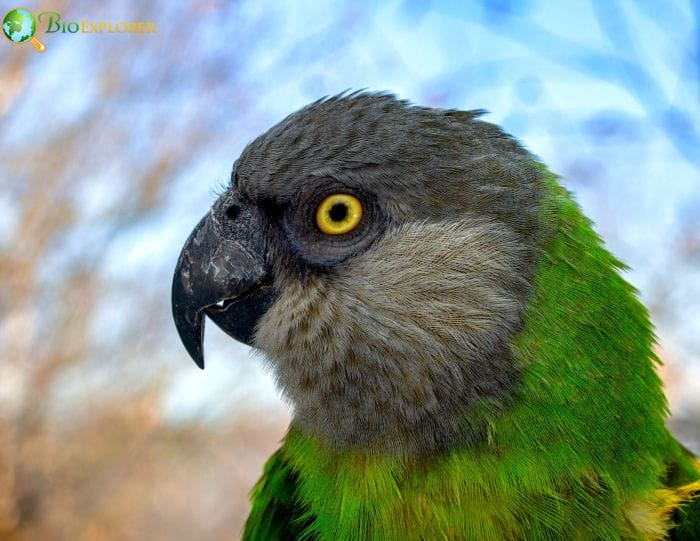
What is the conservation status of the Senegal Parrot?

The Senegal Parrot, also known as poicephalus senegalus, is considered a resident breeder across a wide range in west Africa and has not been globally threatened. They are very common in some areas, but their population can vary greatly depending on the location.
What makes up the diet and nutrition of a Senegal Parrot?
Senegal parrots thrive on a balanced diet made up primarily of fresh fruit and vegetables. They also need a variety of seeds and blossoms. Diet and nutrition are incredibly important for these parrots, and a varied diet will help ensure their health and longevity.
Would a Senegal Parrot make a good pet bird?
Yes, Senegal Parrots tend to make for a good pet bird. They are among the most popular pet birds due to their manageable size of around 10 inches, relatively quiet nature, and playful demeanour which contributes to their outstanding pet quality. It’s recommended to purchase these birds from a reputable breeder or certified pet stores.
Are Senegals known for their talking ability?
While Senegal Parrots aren’t quite as renowned for their talking ability as African Greys, these parrots tend to have a decent ability to mimic human speech. Their natural voice consists of various whistling and clucking sounds.
How long is the lifespan of a Senegal Parrot?
The average lifespan of a Senegal Parrot in captivity, given proper diet and care, typically ranges between 25 and 30 years. This is longer than many other species of parrots, making Senegals a long-term commitment for potential pet owners.
How long after hatching do Senegal Parrots become independent?
Senegal Parrots become independent approximately three months or about 12 weeks after hatching.
What type of traits and behaviors do Senegal Parrots like these exhibits?
Senegal Parrots are generally intelligent, playful, and sometimes mischievous. These parrots tend to become attached to their human caregivers and can bond deeply. It’s important to provide plenty of mental and physical stimulation to keep them happy.
Can I keep two Senegal Parrots together?
Keeping two Senegal Parrots together can be complex. While it can be beneficial for parrots to have companionship, they can also become territorial or aggressive towards each other. It is always essential to introduce new birds carefully.
How do I properly care for a Senegal Parrot?
Senegal Parrots, like any pet bird, require consistent care from their owners. It will be necessary to regularly clean their cage, provide adequate exercise and socialization opportunities, and offer a balanced diet to reduce health risks.
Where can I adopt a Senegal Parrot?
Senegal Parrots are widely available in pet stores and from breeders. Also, parrot rescue organizations often have Senegal Parrots looking for new homes.
With their engaging personality, beauty, and intelligence, it’s easy to understand why Senegal parrots have become superstars in the pet world.
Their ability to form strong social connections and mimic a wide repertoire of sounds only adds to their charismatic appeal.
As this article covered, Senegal parrots exhibit many fascinating qualities from their cooperative wild flock dynamics to advanced physiological adaptions facilitating their forest acrobatics and tool use. Captive-bred Senegals, in particular, make responsive avian partners when properly trained and enriched by caring owners.
While the captive population remains stable, monitoring and regulated management of wild trade is still necessary to secure conservation status as deforestation impacts their specialized ecosystem niche. This iconic West African endemic will continue to charm bird lovers worldwide for years!

























